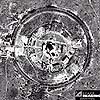| . |  |
. |
Moscow (UPI) Nov 18, 2004 Speaking to the country's top military brass on Wednesday, President Vladimir Putin announced that Russia's nuclear deterrent would soon be significantly upgraded with weapons technology unmatched by other nuclear powers. While making it clear Russia's top security priority is the war against international terrorism, Putin has also signaled that the country's nuclear deterrent will remain a key element of national defense. In what is widely interpreted as a prep talk to Russia's military leadership, Putin boasted of technological breakthroughs that would considerably modernize the country nuclear arsenal. Providing few details, Putin stated, We are not only conducting research and successful test on state-of-the-art nuclear missile systems, but I am convinced that there will appear ... weapons that not a single other nuclear power has, or will have, in the near future. Defense experts in Russia and around the world believe Putin was referring to either a new mobile version of the Topol-M ballistic missile, deployed in silos since 1998, or a significant upgrade of the Bulava intercontinental ballistic missile. Still other analysts contend that Russia is also developing a new generation of heavy missiles with a payload of up to 10 nuclear warheads weighing more than tons - currently a Topol-M has a 1.32-ton warhead capacity. The technological breakthrough suspected is the ability to have warheads detached from the main delivery missile during the final stage of its descent, then to continue the flight as crisis missiles. Such missiles, experts believe, would be able to evade any existing or planned missile defense shield. Russian military officials claim this new technology was successfully tested in February of this year. Putin's announcements were also for international consumption, particularly the United States - vigorously developing its own missile defense shield. Russia strongly protested America's withdrawal from the Anti-Ballistic Missile Treaty in 2002, only to later let the issue pass and develop technologies that would render any U.S. missile defense shield obsolete before complete deployment. The U.S. reaction to Putin's address has been to play down any sense of alarm. White House spokesman Scott McClellan on Wednesday said: This is not something we look at as new. He added, We are very well aware of their longstanding modernization efforts for the military. ... We are allies now in global war on terrorism. While there appears to be little doubt Putin's announcements were to remind the United States and other nuclear powers that Russia will continue to upgrade its nuclear deterrent, Putin's boasts were for more internal consumption. Putin reminded the world that Russia remains a superpower in at least one sense. He also reminded Russians that, like many other reform efforts, the military is also on the mend after almost a decade of decay, low morale, underinvestment, and ineffectiveness in Chechnya. Military reform has been a top priority during Putin's presidency, with only limited results to date. After five years in office, Putin finally felt confident enough to remove top military brass resistant to reforms designed to modernization Russia's military establishment, which remains remarkably Soviet in outlook and structure. Russia's conventional forces remain dangerously weak, with some defense analysts believing that in the case of foreign attack the country might not be able to defend itself. Missile defense is very different, its mere existence serves as a deterrent. Impatient and unable to quicken the pace of conventional forces reform, the Kremlin has changed its military doctrine to compensate for this weakness, and missile defense is seen as the only solution ensuring the country's security. Russia's current national security doctrine, signed by Putin in 2001, allows for use of nuclear weapons if other forms of defense fail. Previously, the use of Russia's nuclear deterrent could only be called into play if it was deemed the country's sovereignty was in peril. Putin's announcement that Russia will continue to support state-of-the-art nuclear deterrence certainly puts would be aggressors on notice. It reminds the United States that Russia is a very meaningful military peer. At home, the military and the average citizen can take pride in the fact that Russia is still a very powerful country in the world. However, in all of this is embedded a very grave danger. If upgrading Russia's nuclear deterrent is a substitute for conventional forces reform, neither Russia nor the world is any safer. Without radical conventional forces reform, the Kremlin has effectively lowered the threshold to use nuclear weapons. Lowering the threshold permitting the use of such weapons only encourages other nuclear powers to do the same. It also may encourage some countries that do not have nuclear weapons to acquire them. Breakthroughs in military technology cannot ensure Russia's security, but well-trained, modern, and highly motivated ground forces can. One has to wonder if the Kremlin is opting to be smart instead of practical. Peter Lavelle is an independent Moscow-based analyst and the author of the electronic newsletter on Russia Untimely Thoughts untimely-thoughts.com. Related Links SpaceDaily Search SpaceDaily Subscribe To SpaceDaily Express
 Washington DC (UPI) Nov 18, 2004
Washington DC (UPI) Nov 18, 2004President Jimmy Carter's national security adviser Zbigniew Brzezinski was the first senior U.S. official to argue that U.S. security required Washington to accept Islamabad's nuclear program. |
|
| The content herein, unless otherwise known to be public domain, are Copyright 1995-2006 - SpaceDaily.AFP and UPI Wire Stories are copyright Agence France-Presse and United Press International. ESA PortalReports are copyright European Space Agency. All NASA sourced material is public domain. Additionalcopyrights may apply in whole or part to other bona fide parties. Advertising does not imply endorsement,agreement or approval of any opinions, statements or information provided by SpaceDaily on any Web page published or hosted by SpaceDaily. Privacy Statement |